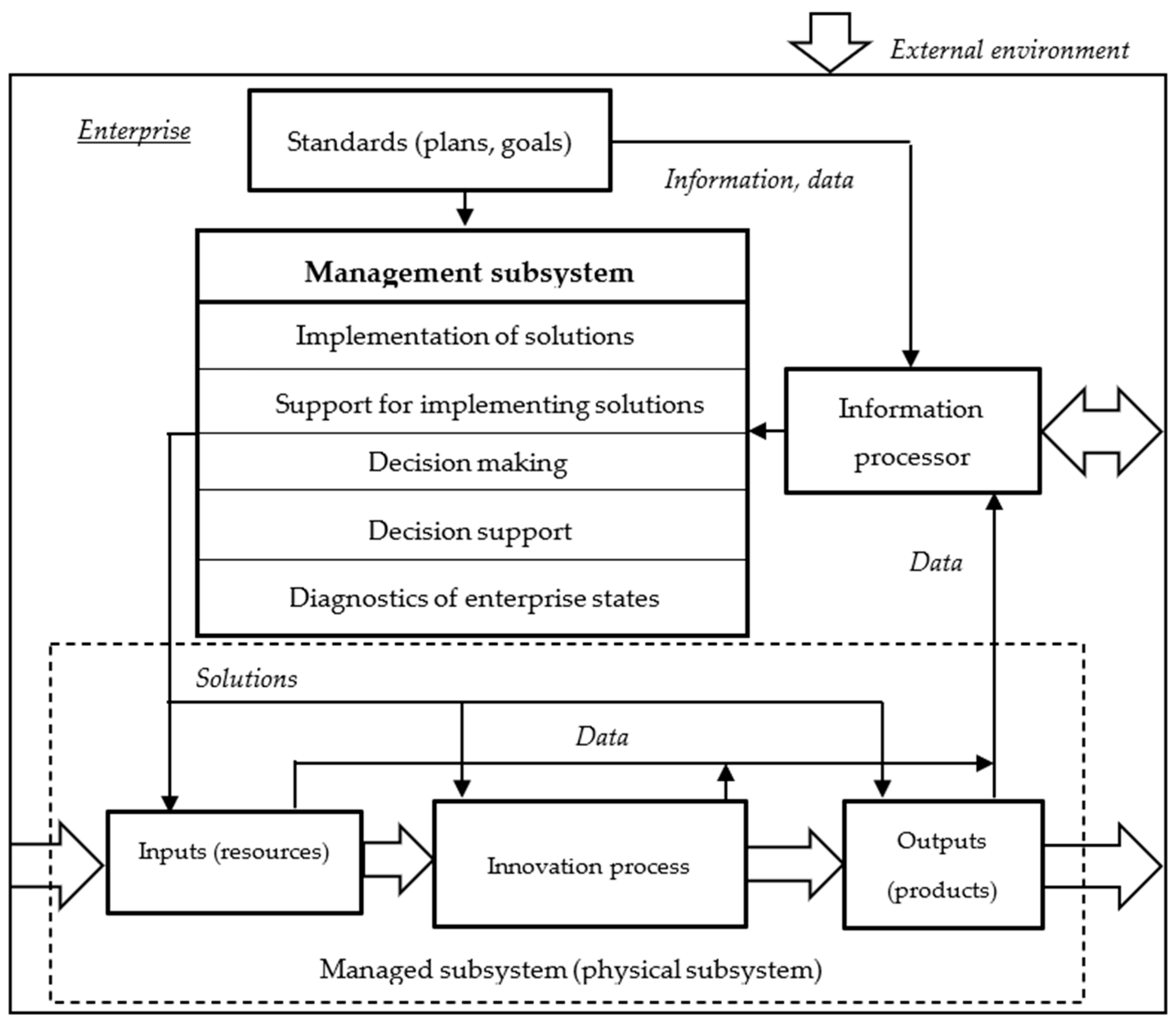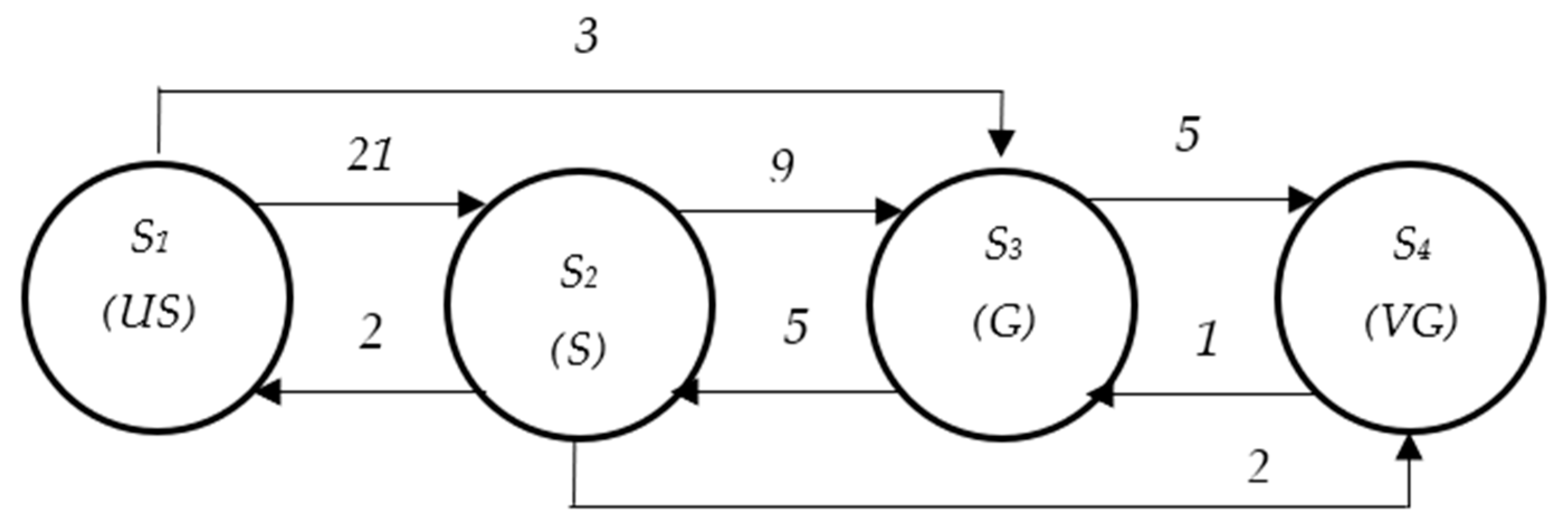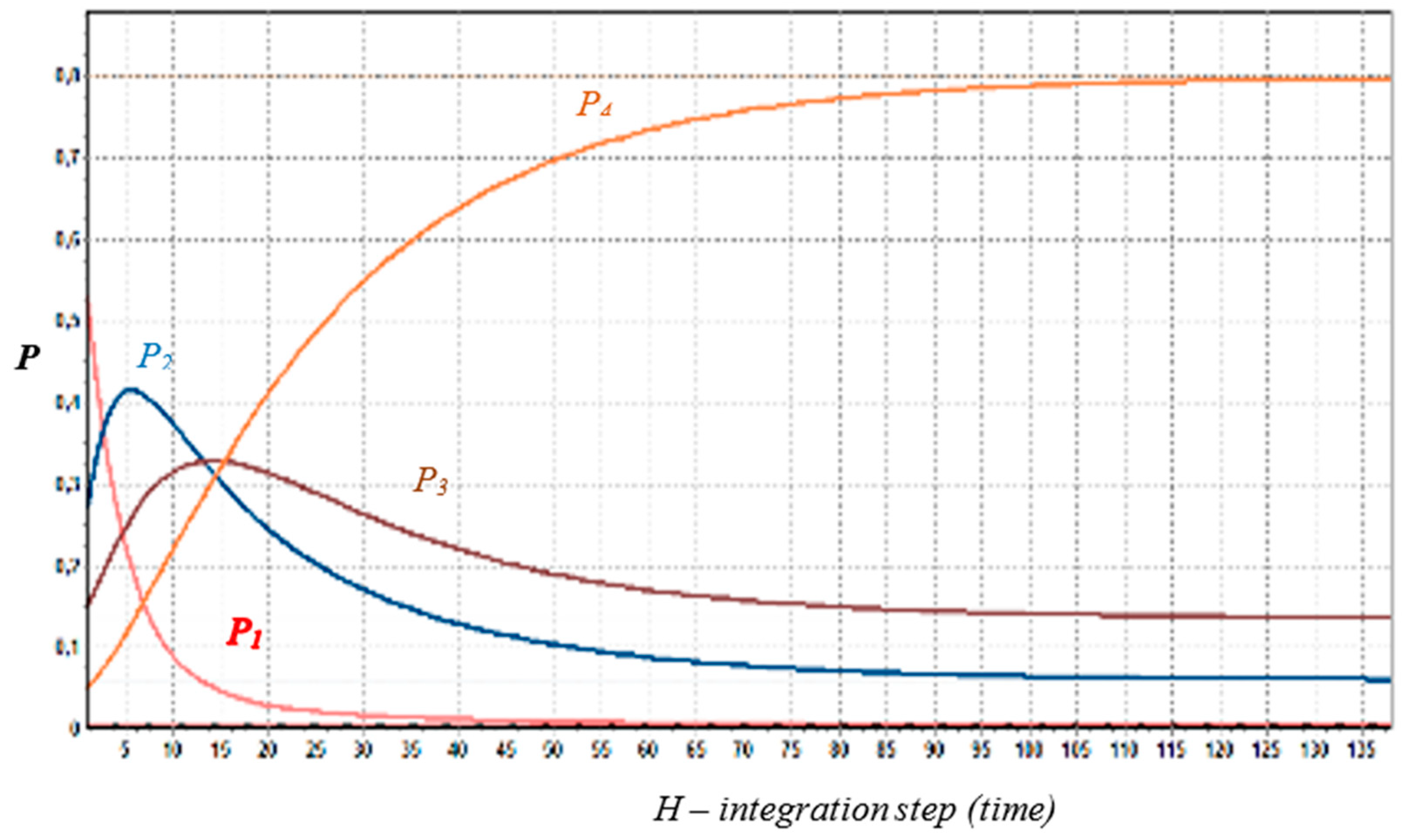Intelligent Management of Enterprise Business Processes
Abstract
1. Introduction
2. Literature Review
3. Methods
4. Results
4.1. System Model of an Enterprise as a Basis for Intelligent Management
- A physical subsystem (managed subsystem) that includes input resources, an innovative (technological) process, and output products;
- A management subsystem, which includes a cybernetic (virtual) subsystem that contains a feedback loop, diagnoses the states of the physical system, and supports the making and implementation of management decisions;
- Person—a manager who makes the decision.
- Decision makers (managers);
- A virtual subsystem that diagnoses enterprise states and supports decision-making and implementation;
- Information processor and standards (plans, goals).
4.2. The Features of Making Managerial Decisions during Intelligent Enterprise Management
- Methods and procedures for operations research that allow you to develop recommendations for quantitative analysis necessary for planning and organizing targeted actions;
- Methods of system analysis used to determine tasks and choose the direction of action, to assess how systems act under conditions of uncertainty;
- Methods of system engineering used for the design and synthesis of complex systems based on the study of the features of the functioning of their elements.
- Assessment of circumstances to determine the conditions that you need to know for making decisions;
- Search, develop, and analyze possible alternative actions;
- Choosing one direction of action from possible alternatives in such a way that a certain goal is achieved.
- Qualifications of the decision-maker, who determines its quality;
- Preparation level of the person who implements the solution, which determines the quality of its implementation;
- The degree of improvement of the information system (clarity, efficiency), which determines the quality of feedback between these categories of managers and the environment.
4.3. The Human Factor in Intelligent Enterprise Management
- P (prophets);
- G (geniuses);
- T (talents);
- C (capable);
- N (normal);
- O (others).
4.4. The Problem of Assessing and Forecasting the State of Enterprise Development in the Context of Intellectual Management
- Dynamics of probabilities of states and stability of development of enterprises and their employees;
- Dynamics of probabilities of states for innovative and technological processes;
- Scientific and technological, environmental, social and economic efficiency of enterprises.
5. Discussion
6. Conclusions
Author Contributions
Funding
Data Availability Statement
Conflicts of Interest
References
- Russell, S.J.; Norvig, P. Artificial Intelligence: A Modern Approach, 3rd ed.; Prentice Hall: Hoboken, NJ, USA, 2010. [Google Scholar]
- Pereira, A.C.; Romero, F. A review of the meanings and the implications of the industry 4.0 concept. Procedia Manuf. 2017, 13, 1206–1214. [Google Scholar] [CrossRef]
- Ruppert, T.; Jaskó, S.; Holczinger, T.; Abonyi, J. Enabling technologies for operator 4.0: A survey. Appl. Sci. 2018, 8, 1650. [Google Scholar] [CrossRef]
- Alcácer, V.; Cruz-Machado, V. Scanning the industry 4.0: A literature review on technologies for manufacturing systems. Eng. Sci. Technol. Int. J. 2019, 22, 899–919. [Google Scholar] [CrossRef]
- Antonescu, M. Are business leaders prepared to handle the upcoming revolution in business artificial intelligence? Calitatea 2018, 19, 15–19. [Google Scholar]
- Lee, J.; Suh, T.; Roy, D.; Baucus, M. Emerging Technology and Business Model Innovation: The Case of Artificial Intelligence. J. Open Innov. Technol. Mark. Complex. 2019, 5, 44. [Google Scholar] [CrossRef]
- Garbuio, M.; Lin, N. Artificial intelligence as a growth engine for health care startups: Emerging business models. Calif. Manag. Rev. 2019, 61, 59–83. [Google Scholar] [CrossRef]
- Babiceanu, R.F.; Seker, R. Big data and virtualization for manufacturing cyber-physical systems: A survey of the current status and future outlook. Comput. Ind. 2016, 81, 128–137. [Google Scholar] [CrossRef]
- Kar, A.K. A hybrid group decision support system for supplier selection using analytic hierarchy process, fuzzy set theory and neural network. J. Comput. Sci. 2015, 6, 23–33. [Google Scholar] [CrossRef]
- Saha, C.; Aqlan, F.; Lam, S.S.; Boldrin, W. A decision support system for real-time order management in a heterogeneous production environment. Expert Syst. Appl. 2016, 60, 16–26. [Google Scholar] [CrossRef]
- Zhou, H.; Noble, C.; Cotter, J. A big data based intelligent decision support system for sustainable regional development. In Proceedings of the 2015 IEEE International Conference on Smart City/SocialCom/SustainCom (SmartCity), Chengdu, China, 19–21 December 2015; pp. 822–826. [Google Scholar] [CrossRef]
- Galbraith, J.R. Designing Organizations: Strategy, Structure, and Process at the Business Unit and Enterprise Levels, 3rd ed.; Jossey-Bass & Pfeiffer Imprints: Wiley, NJ, USA, 2014. [Google Scholar]
- Miller, J.H.; Page, S.E. Complex Adaptive Systems: An Introduction to Computational Models of Social Life, STU—Student ed.; Princeton University Press: Princeton, NJ, USA, 2007. [Google Scholar]
- Odrekhivskyy, M.; Kunanets, N.; Pasichnyk, V.; Rzheuskyi, A.; Tabachyshyn, D. Information-Analytical Support for the Processes of Formation of “Smart Sociopolis” of Truskavets. 2019. Available online: https://ceur-ws.org/Vol-2393/paper_186.pdf (accessed on 11 November 2022).
- Tanajura, A.P.M.; Oliveira, V.L.C.; Lepikson, H. A Multi-agent Approach for Production Management. In Industrial Engineering, Management Science and Applications 2015. Lecture Notes in Electrical Engineering; Gen, M., Kim, K., Huang, X., Hiroshi, Y., Eds.; Springer: Berlin/Heidelberg, Germany, 2015; Volume 349. [Google Scholar] [CrossRef]
- Dipalokareswara, A.; Supriana, I.; Surendro, K. An overview of multi agent system approach in knowledge management model. In Proceedings of the International Conference on Information Technology Systems and Innovation (ICITSI), Bandung, Indonesia, 24–27 November 2014. [Google Scholar] [CrossRef]
- Chakir, A.; Chergui, M.; Elhasnaou, S.; Medromi, H.; Sayouti, A. A decision approach to select the best framework to treat an IT problem by using multi-agent system and expert systems. In Advances in Ubiquitous Networking; Springer: Singapore, 2016; pp. 499–511. [Google Scholar] [CrossRef]
- Kamble, D.R. Architectural Review on Multi Agent Knowledge Management. Int. J. Sci. Technol. Res. 2013, 2, 105–114. [Google Scholar]
- Wang, S.; Wan, J.; Zhang, D.; Li, D.; Zhang, C. Towards smart factory for industry 4.0: A self-organized multi-agent system with big data based feedback and coordination. Comput. Netw. (Amst. Neth. 1999) 2016, 101, 158–168. [Google Scholar] [CrossRef]
- Foss, N.J.; Saebi, T. Fifteen years of research on business model innovation: How far have we come, and where should we go? J. Manag. 2017, 43, 200–227. [Google Scholar] [CrossRef]
- Li, F. The digital transformation of business models in the creative industries: A holistic framework and emerging trends. Technovation 2020, 92–93, 102012. [Google Scholar] [CrossRef]
- Gassmann, O.; Frankenberger, K.; Sauer, R. A Primer on Theoretically Exploring the Field of Business Model Innovation. 2017. Available online: https://www.europeanbusinessreview.com/a-primer-on-theoretically-exploring-the-field-of-business-model-innovation/ (accessed on 20 November 2022).
- Obschonka, M.; Audretsch, D.B. Artificial intelligence and big data in entrepreneurship: A new era has begun. Small Bus Econ. 2020, 55, 529–539. [Google Scholar] [CrossRef]
- Brown, A. Industry 4.0: The Ways in Which Technology is Transforming Industry. 2019. Available online: https://interestingengineering.com/industry-40-the-ways-in-which-technology-is-transforming-industry (accessed on 20 November 2022).
- Marr, B. What is Industry 4.0? Here’s A Super Easy Explanation for Anyone. 2018. Available online: https://www.forbes.com/sites%20/bernardmarr/2018/09/02/what-is-industry-4-0-heres-a-super-easy-explanation-for-anyone/ (accessed on 20 November 2022).
- Dalenogare, L.S.; Benitez, G.B.; Ayala, N.F.; Frank, A.G. The expected contribution of industry 4.0 technologies for industrial performance. Int. J. Prod. Econ. 2018, 204, 383–394. [Google Scholar] [CrossRef]
- Johnson, B. The Combination of Human and Artificial Intelligence Will Define Humanity’s Future; AOL Inc.: New York, NY, USA, 2016. [Google Scholar]
- Daugherty, P.R.; Wilson, H.J. Human + Machine: Reimagining Work in the Age of AI; Harvard Business Review Press: Boston, MA, USA, 2018. [Google Scholar]
- Fourtané, S. Human + Machine Collaboration: Work in the Age of Artificial Intelligence. 2019. Available online: https://interestingengineering.com/human-machine-collaboration-work-in-the-age-of-artificial-intelligence (accessed on 20 November 2022).
- Abbasi, A.; Sarker, S.; Chiang, R.; University of Cincinnati; University of Virginia; Aalto University. Big data research in information systems: Toward an inclusive research agenda. J. Assoc. Inf. Syst. 2016, 17, I–XXXII. [Google Scholar] [CrossRef]
- Dornberger, R.; SpringerLink (Online Service). Business Information Systems and Technology 4.0: New Trends in the Age of Digital Change; Springer International Publishing: Berlin/Heidelberg, Germany, 2018. [Google Scholar] [CrossRef]
- Abramowicz, W.; Mayr, H.C. Technologies for Business Information Systems, 1st ed.; Springer: Berlin/Heidelberg, Germany, 2007. [Google Scholar] [CrossRef]
- Kuwashima, K. How to use models of organizational decision making? Ann. Bus. Adm. Sci. 2014, 13, 215–230. [Google Scholar] [CrossRef][Green Version]
- Turpin, M.; Marais, M. Decision-Making: Theory and Practice. ORiON 2004, 20, 143–160. [Google Scholar] [CrossRef]
- Hatch, M.J.; Cunliffe, A.L. Organization Theory: Modern, Symbolic and Postmodern Perspectives, 3rd ed.; Oxford University Press: Oxford, UK, 2012; Available online: http://libsearch.cbs.dk/primo_library/libweb/action/dlDisplay.do?docId=CBS01000589624&vid=CBS&afterPDS=true (accessed on 20 November 2022).
- Daft, R.L. Organization Theory & Design, 12th ed.; Cengage Learning: Boston, MA, USA, 2016. [Google Scholar]
- Bourgeois, D.T. Information Systems for Business and Beyond, Textbook equity ed.; Saylor Academy: Washington, DC, USA, 2014. [Google Scholar]
- Baltzan, P. Business Driven Information Systems, 6th ed.; McGraw-Hill Education: New York, NY, USA, 2019. [Google Scholar]
- Beynon-Davies, P. Business Information Systems, 3rd ed.; Red Globe Press: London, UK, 2019. [Google Scholar]
- Rashidi, M.; Ghodrat, M.; Samali, B.; Masoud Mohammadi, M. Decision Support Systems. In Management of Information Systems; IntechOpen: London, UK, 2018. [Google Scholar] [CrossRef]
- Marakas, G. Decision Support Systems, 2nd ed.; Prentice Hall: Hoboken, NJ, USA, 2003. [Google Scholar]
- Sharda, R.; Delen, D.; Turban, E. Business Intelligence, Analytics, and Data Science: A Managerial Perspective, 4th ed.; Pearson: London, UK, 2018. [Google Scholar]
- François, C. International Encyclopedia of Systems and Cybernetics; K. G. Saur: Boston, MA, USA, 2011. [Google Scholar] [CrossRef]
- Power, D.J. Decision Support Systems: Concepts and Resources for Managers; Quorum Books: Westport, CT, Canada, 2002. [Google Scholar]
- Manggai, B.; bin Thukiman, K.; bin Othman, M.; bin Abdul Majid, M. Organizational Culture and Ethics in Decision-Making. Int. J. Eng. Technol. 2018, 7, 257–259. [Google Scholar] [CrossRef]
- Ahmed, A.H.; Bwisa, H.M.; Otieno, R.O.; Karanja, K. Strategic Decision Making: Process, Models, and Theories. Bus. Manag. Strategy 2014, 5, 78–104. [Google Scholar] [CrossRef]
- Verma, D. Study and Analysis of Various Decision Making Models in an Organization. J. Bus. Manag. 2014, 16, 171–175. [Google Scholar] [CrossRef]
- Dennis, A.; Wixom, B.H.; Roth, R.M. Systems Analysis and Design, 8th ed.; John Wiley and Sons: Hoboken, NJ, USA, 2022. [Google Scholar]
- Dennis, A.; Wixom, B.H.; Tegarden, D.P.; Seeman, E. System Analysis & Design: An Object-Oriented Approach with UML, 5th ed.; Wiley: Hoboken, NJ, USA, 2015. [Google Scholar]
- Aliyev, A.G. Economic-Mathematical Methods and Models under Uncertainty; Apple Academic Press: Palm Bay, FL, USA, 2014. [Google Scholar]
- Fuente, A. Mathematical Methods and Models for Economists; Cambridge University Press: Cambridge, UK, 2000. [Google Scholar] [CrossRef]
- Madisetti, V. Digital Signal Processing Fundamentals, 1st ed.; CRC Press: Boca Raton, FL, USA, 2010. [Google Scholar] [CrossRef]
- Sriram, S.; Ramachandran, M.; Chinnasamy, S.; Mathivanan, G. A Review on Multi-Criteria Decision-Making and Its Application. REST J. Emerg. Trends Model. Manuf. 2022, 7, 101–107. [Google Scholar]
- Bratko, A.; Kocherhin, A. Information and the Psyche; Nauka: Moscow, Russia, 1977. [Google Scholar]
- Odrechivskyy, M.; Kolomatskyy, V. Psychological problems of innovation management. In Proceedings of the 2nd International Scientific Conference «Modern Trends in Scientific thought Development», Vancouver, BC, Canada, 18–21 January 2022. [Google Scholar]
- Cherri, K. People and Information; Svyaz: Moscow, Russia, 1972. [Google Scholar]
- Kanyhin, Y. Fundamentals of Cognitive Social Science (Information Theory of Social Systems); Ukrainian Academy of Computer Science: Kyiv, Ukraine, 1993. [Google Scholar]
- Vendrell-Herrero, F.; Parry, G.; Bustinza, O.F.; Gomes, E. Digital business models: Taxonomy and future research avenues. Strateg. Change 2018, 27, 87–90. [Google Scholar] [CrossRef]
- Odrekhivskyi, M.; Kohut, U.; Kochan, R.; Karpinskyi, V.; Bernas, M. Problems of environmental innovation systems design. In Proceedings of the 19th International Multidisciplinary Scientific Geoconference SGEM, Albena, Bulgaria, 28 June–7 July 2019. [Google Scholar]
- Odrekhivskyy, M.; Pasichnyk, V.; Kunanets, N.; Rzheuskyi, A.; Korz, G.; Tabachyshyn, D. The Use of Modern Information Technology in Medical and Health Institutions of Truskavets Resort. 2020. Available online: https://ceur-ws.org/Vol-2631/paper14.pdf (accessed on 20 November 2022).
- Fauska, P.; Kryvinska, N.; Strauss, C. The Role of E-Commerce in B2B Markets of Goods and Services. Int. J. Serv. Econ. Manag. 2013, 5, 41–71. [Google Scholar] [CrossRef]
- Tan, L.; Jiang, J. Digital Signal Processing: Fundamentals and Applications, 3rd ed.; Academic Press: Cambridge, MA, USA, 2019. [Google Scholar]
- Urikova, O.; Ivanochko, I.; Kryvinska, N.; Strauss, C.; Zinterhof, P. Consideration of Aspects Affecting the Evolvement of Collaborative eBusiness in Service Organizations. Int. J. Serv. Econ. Manag. 2013, 5, 72–92. [Google Scholar]
- Lupenko, S.A. Theoretical Bases of Modeling and Processing of Cyclic Signals in Information Systems; Magnolia: Lviv, Ukraine, 2016. [Google Scholar]
- Hamming, R.W. Numerical Methods for Scientists and Engineers (Dover Books on Mathematics), 2nd Revised ed.; Dover Publications: New York, NY, USA, 1987; 752p. [Google Scholar]




Disclaimer/Publisher’s Note: The statements, opinions and data contained in all publications are solely those of the individual author(s) and contributor(s) and not of MDPI and/or the editor(s). MDPI and/or the editor(s) disclaim responsibility for any injury to people or property resulting from any ideas, methods, instructions or products referred to in the content. |
© 2022 by the authors. Licensee MDPI, Basel, Switzerland. This article is an open access article distributed under the terms and conditions of the Creative Commons Attribution (CC BY) license (https://creativecommons.org/licenses/by/4.0/).
Share and Cite
Odrekhivskyi, M.; Pshyk-Kovalska, O.; Zhezhukha, V.; Ivanochko, I. Intelligent Management of Enterprise Business Processes. Mathematics 2023, 11, 78. https://doi.org/10.3390/math11010078
Odrekhivskyi M, Pshyk-Kovalska O, Zhezhukha V, Ivanochko I. Intelligent Management of Enterprise Business Processes. Mathematics. 2023; 11(1):78. https://doi.org/10.3390/math11010078
Chicago/Turabian StyleOdrekhivskyi, Mykola, Orysya Pshyk-Kovalska, Volodymyr Zhezhukha, and Iryna Ivanochko. 2023. "Intelligent Management of Enterprise Business Processes" Mathematics 11, no. 1: 78. https://doi.org/10.3390/math11010078
APA StyleOdrekhivskyi, M., Pshyk-Kovalska, O., Zhezhukha, V., & Ivanochko, I. (2023). Intelligent Management of Enterprise Business Processes. Mathematics, 11(1), 78. https://doi.org/10.3390/math11010078








